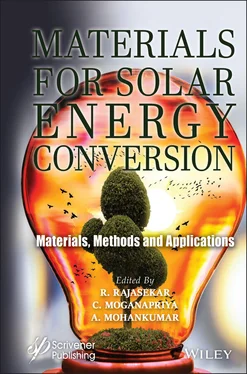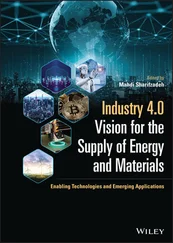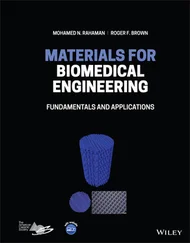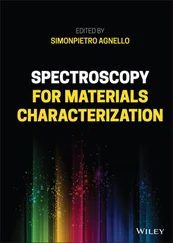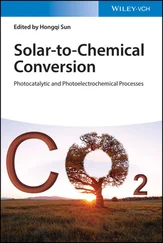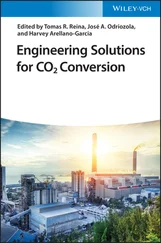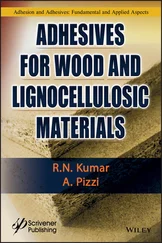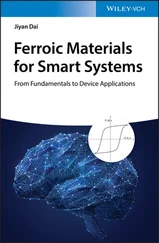Materials for Solar Energy Conversion
Здесь есть возможность читать онлайн «Materials for Solar Energy Conversion» — ознакомительный отрывок электронной книги совершенно бесплатно, а после прочтения отрывка купить полную версию. В некоторых случаях можно слушать аудио, скачать через торрент в формате fb2 и присутствует краткое содержание. Жанр: unrecognised, на английском языке. Описание произведения, (предисловие) а так же отзывы посетителей доступны на портале библиотеки ЛибКат.
- Название:Materials for Solar Energy Conversion
- Автор:
- Жанр:
- Год:неизвестен
- ISBN:нет данных
- Рейтинг книги:5 / 5. Голосов: 1
-
Избранное:Добавить в избранное
- Отзывы:
-
Ваша оценка:
- 100
- 1
- 2
- 3
- 4
- 5
Materials for Solar Energy Conversion: краткое содержание, описание и аннотация
Предлагаем к чтению аннотацию, описание, краткое содержание или предисловие (зависит от того, что написал сам автор книги «Materials for Solar Energy Conversion»). Если вы не нашли необходимую информацию о книге — напишите в комментариях, мы постараемся отыскать её.
This book provides professionals and students with a resource on the basic principles and applications of solar energy materials and processes, as well as practicing engineers who want to understand how functional materials operate in solar energy conversion systems.
Audience
Materials for Solar Energy Conversion — читать онлайн ознакомительный отрывок
Ниже представлен текст книги, разбитый по страницам. Система сохранения места последней прочитанной страницы, позволяет с удобством читать онлайн бесплатно книгу «Materials for Solar Energy Conversion», без необходимости каждый раз заново искать на чём Вы остановились. Поставьте закладку, и сможете в любой момент перейти на страницу, на которой закончили чтение.
Интервал:
Закладка:
9 Chapter 9Figure 9.1 Diagrammatic illustration of fundamental principles of a p-n junction...Figure 9.2 Schematic representation of electrical equivalent circuits of solar c...Figure 9.3 (a) Figure showing the two-step spin-coating, adapted from ref. [48],...Figure 9.4 (a) Illustration of the Slot-Die coating technique, adopted from ref....Figure 9.5 The bandgap energy as well as the crystal structure comparison for va...Figure 9.6 (a) % transmittance vs. sheet resistance plot of graphene as a functi...Figure 9.7 (a) Diagrammatic illustration of a typical OSC device structure and f...Figure 9.8 (a) Diagrammatic illustration of a typical OSC device with graphene e...Figure 9.9 Schematic representation of direct and inverted PSCs with planner and...Figure 9.10 (a) Diagrammatic illustration of working principle of a general DSSC...Figure 9.11 Photocurrent density vs. voltage curves of the DSSCs where the count...
10 Chapter 10Figure 10.1 Classification of solar cells.Figure 10.2 (a) Schematic diagram of the constructed solar cell and (b) I – V char...Figure 10.3 Surface reflectance (a) and I–V characteristics curves (b) of thin fi...Figure 10.4 Schematic representation of spin coating processes with single and d...Figure 10.5 Schematic representation of atmospheric pressure chemical vapor depo...
11 Chapter 11Figure 11.1 Thin film deposition techniques.Figure 11.2 Sol-gel deposition techniques.Figure 11.3 Schematic diagram of X-ray diffraction.Figure 11.4 Schematic diagram of Bragg diffraction.Figure 11.5 Schematic representation of FTIR.Figure 11.6 Photography image of TGA and DTA (Source: CRF Laboratory, IIT Kharag...Figure 11.7 UV-vis spectrometer.Figure 11.8 Schematic representation of FE-SEM.Figure 11.9 Schematic representation of HR-TEM.Figure 11.10 Schematic diagram of AFM.Figure 11.11 Four probe method.
12 Chapter 12Figure 12.1 The components of solar panel [19].Figure 12.2 Reflection of sunlight rays from cover glass and cell of solar panel...Figure 12.3 Phenomenon of reflection loss elimination through ARC on solar cell.Figure 12.4 Mechanism of reflection loss in multilayer ARC.Figure 12.5 Classification of anti-reflection coating.Figure 12.6 Behavior of light rays on the normal flat and textured surface.Figure 12.7 Systematic process of spin coating technique using sol-gel.Figure 12.8 Three stages of the dip coating technique using sol-gel.Figure 12.9 Process of sol-gel coating through meniscus technique.Figure 12.10 Solar cell coating with help of thermal evaporation PVD method.Figure 12.11 Anti-reflection coating through electron beam PVD method.Figure 12.12 Image of (a) DC magnetron sputtering technique and (b) RF magnetron...Figure 12.13 Chemical vapor deposition method by hot wall CVD and LPCVD is repre...Figure 12.14 ARC coating through electrospinning technique.Figure 12.15 The mechanism of the spray pyrolysis technique for ARC coating is r...Figure 12.16 Working procedure of the lithography technique to coat ARC on solar...Figure 12.17 Comparison of reflectance (%) measured from both front and back of ...Figure 12.18 (a) Reflectance (%) vs. wavelength (nm) graph comparing the result ...Figure 12.19 Reflection (%) vs. wavelength (nm) graph of bare glass substrate an...
13 Chapter 13Figure 13.1 Schematic representation of TES.Figure 13.2 Step-by-step phase change process of a solid-liquid PCM.Figure 13.3 Classification of solid-liquid PCM [4].Figure 13.4 Schematic of solar pond.Figure 13.5 Domestic solar water heating system.Figure 13.6 Schematic of packed rock bed storage [10].Figure 13.7 SEM micrograph of microencapsulated paraffin.Figure 13.8 (a) PCM encapsulated in spheres [14]. (b) PCM encapsulated in panels...Figure 13.9 Solar water heater with encapsulated PCM.Figure 13.10 TIM-PCM wall of the test room.Figure 13.11 Schematic plan of PCM incorporation in buildings.Figure 13.12 Structure of a novel cooling RC-PCM wall.Figure 13.13 (a) Cold thermal energy storage tank. (b) Photographic view of heat...Figure 13.14 Cylindrical modules inserted into storage tank.Figure 13.15 Scheme of building energy system.Figure 13.16 ITC/TSM TRNSYS schematic.Figure 13.17 The design of plate heat exchanger.Figure 13.18 (a) The LHTES system with solar collector. (b) Schematic of experim...
List of Tables
1 Chapter 1 Table 1.1 Global industrial energy consumption pattern by fuel in 2020 and 2050 ... Table 1.2 Various sources of energy. Table 1.3 Renewable energy sources, annual production, and global demand [40]. Table 1.4 Energy conversion [11]. Table 1.5 Difference in renewable and non-renewable energy sources. Table 1.6 Types of solar collectors [12]. Table 1.7 Utilization of heat in industries and their operating temperature rang... Table 1.8 Types of solar energy applications and technologies involved in a syst...
2 Chapter 2 Table 2.1 First-generation PV cells. Table 2.2 Second-generation PV cells. Table 2.3 Third-generation PV cells.
3 Chapter 3 Table 3.1 Silicon solar module recycling processes [5] (Reproduced and obtained ... Table 3.2 Thin-film solar module recycling methods [5] (Reproduced and obtained ... Table 3.3 Comparison of solar-panel recycling technologies [4] (Reproduced and o...Table 3.4 Silicon solar modules recycling processes [31] (Reproduced and request...Table 3.5 Thin-film solar modules recycling processes [31] (Reproduced and reque...
4 Chapter 4Table 4.1 Key issues for recognizing high-efficiency multi-junction cells [32].Table 4.2 Influence of bottom cell BSF layer thickness on performances of the ce...Table 4.3 Efficiency of multi-junction cells [34].Table 4.4 Power conversion efficiency of multi-junction cells with stack structu...
5 Chapter 5Table 5.1 Comparison of several solar cell parameters.Table 5.2 Comparison of various cell performances of perovskite cell architectur...
6 Chapter 6Table 6.1 Chemical structures of natural dye classes [15].Table 6.2 Photovoltaic performance of DSSC utilizing various natural dyes as pho...
7 Chapter 7Table 7.1 Device structures and their efficiency [11].
8 Chapter 9Table 9.1 Photovoltaic properties of inorganic 2D material-based perovskite sola...
9 Chapter 12Table 12.1 Various ARC material with their reflection index [50].Table 12.2 Comparison of ARC coating techniques.
10 Chapter 13Table 13.1 Some commonly available SHS materials.Table 13.2 Some organic PCMs from the literatures [5–7].Table 13.3 Some inorganic PCMs from the literatures [6].Table 13.4 Some eutectic PCMs available in the literature [6, 8, 9].
Pages
1 v
2 ii
3 iii
4 iv
5 xv
6 1
7 3
8 4
9 5
10 6
11 7
12 8
13 9
14 10
15 11
16 12
17 13
18 14
19 15
20 16
21 17
22 18
23 19
24 20
25 21
26 22
27 23
28 24
29 25
30 26
31 27
32 28
33 29
34 30
35 31
36 33
37 34
38 35
39 36
40 37
41 38
42 39
43 40
44 41
45 42
46 43
47 44
48 45
49 46
50 47
51 48
52 49
53 50
54 51
55 52
56 53
57 54
58 55
59 56
60 57
61 58
62 59
63 60
64 61
65 62
66 63
67 64
68 65
69 66
70 67
71 68
72 69
73 70
74 71
75 72
76 73
77 74
78 75
79 76
80 77
81 78
82 79
83 80
84 81
85 82
86 83
87 84
88 85
89 86
90 87
91 88
92 89
93 90
94 91
95 92
96 93
97 94
98 95
99 96
100 97
101 98
102 99
103 100
104 101
105 102
106 103
107 104
108 105
109 106
110 107
Читать дальшеИнтервал:
Закладка:
Похожие книги на «Materials for Solar Energy Conversion»
Представляем Вашему вниманию похожие книги на «Materials for Solar Energy Conversion» списком для выбора. Мы отобрали схожую по названию и смыслу литературу в надежде предоставить читателям больше вариантов отыскать новые, интересные, ещё непрочитанные произведения.
Обсуждение, отзывы о книге «Materials for Solar Energy Conversion» и просто собственные мнения читателей. Оставьте ваши комментарии, напишите, что Вы думаете о произведении, его смысле или главных героях. Укажите что конкретно понравилось, а что нет, и почему Вы так считаете.
